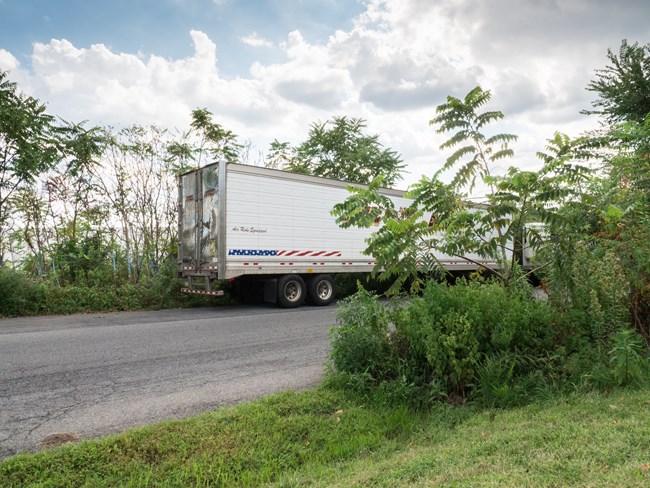Last updated: May 24, 2023
Article
On a Squishin’ Mission: The Fight Against Spotted Lanternflies

Photo/United States Department of Agriculture
Written by Kristin Vinduska, NPS
This colorful insect is one you don’t want to spot! Spotted lanternflies (SLF), natives of Asia, were first discovered in the United States in 2014 in Berks County, Pennsylvania. Since their initial detection, SLF have been found in Delaware, Indiana, Maryland, Massachusetts, Michigan, New Jersey, New York, North Carolina, Ohio, Pennsylvania, Rhode Island, Virginia, and West Virginia. On September 28, 2021, the Massachusetts Department of Agricultural Resources (MDAR) announced that a small, established, and breeding population of SLF was detected in Worcester County, in the city of Fitchburg. A map maintained by MDAR shows the findings from 2022.
Spotted lanternflies are plant-hoppers in the family Fulgoridae and the order Hemiptera, a group of sap-feeding plant pests. It is thought that these hitchhikers may have arrived in the United States as egg masses (New York State Integrated Pest Management). Egg masses can be deposited in hard-to-detect places making them easy to transport unintentionally. Despite their name, spotted lanternflies are poor fliers and can only travel up to a few miles during their lifespan - mainly by walking, jumping and flying. Transportation by human activity is the most common form of long-distance movement.
Spotted lanternflies have shown in current infestations to have one generation per year consisting of four nymphal stages, an adult stage, and an overwintering stage as egg masses. SLF hatch between May and June starting out as a first instar nymph that appears black with white spots and is approximately ¼ of an inch long. An instar is a stage in the life of an arthropod (such as an insect) between two successive molts. This appearance continues through the second and third instar stages from June to July. During the fourth instar stage in July through September, the SLF develops into a red coloration with white spots and can be up to ¾ of an inch long. Fourth instar nymphs molt during this same time and become adults who are active from July to December. Adults have black-spotted, pinkish-tan wings folded over their bodies like a tent when at rest. They are approximately one inch long. When adult SLF are startled or ready to take flight, their red, white, and black underwings will show. Both male and female SLF have yellow abdomens with black stripes but when a female has mated, this abdomen will swell. Mating takes place in late August which leads to egg-laying in September through November.

Graphic/New York Integrated Pest Management
Females lay one or two egg masses in rows that are covered in white substance that becomes pinkish-gray and darker tan as it dries (similar to dry mud). Each mass can contain 30 to 60 eggs and may be deposited in places that are difficult to notice. Checking for egg masses in hidden places to make sure they are not transported can help prevent SLF spread.
When spotted lanternfly seeks out food it will use its straw-like mouthparts to tap into the vascular tissue of a tree and remove sap. The byproduct of sap intake is called honeydew. This sugary substance attracts bees, wasps, and other insects. Honeydew can build up and promote the growth of sooty mold, which can look like a black coating at the base of the host plant. The sooty mold can make it harder for the plant to survive. More than 100 species of ornamental trees, fruit-bearing trees, and vines can serve as a host for the spotted lanternfly to use for feeding and as a place to lay eggs. Preferred host plants are marked with an asterisk (*).

Photo/United States Department of Agriculture
Some species include:
- apple/crabapple (Malus spp.)
- Asiatic bittersweet (Celastrus orbiculatus)
- birch (Betula spp.)*
- black walnut (Juglans nigra)*
- grapes (Vitis spp.)*
- highbush blueberry (Vaccinium angustifolium)
- hops (Humulus lupulus)
- lilac (Syringa spp.)
- maple (Acer spp.)*
- mulberry (Morus spp.)
- poplar (Populus spp.)
- rose (Rosa spp.)*
- staghorn sumac (Rhus typhina)*
- stone fruit (cherry, peach, plum, etc.) (Prunus spp.)
- sycamore (Platanus spp.)
- tree of heaven (Ailanthus altissima)*
- Virginia creeper (Parthenocissus quinquefolia)
- willow (Salix spp.)*
This makes the spotted lanternfly a threat to agriculture. SLF can cause major losses of crops and millions of dollars in damage. This has been observed in Pennsylvania in viticulture (grapes), fruit tree, plant nursery and timber industries. SLF prefer to use the non-native tree of heaven (Ailanthus altissima) as their host plant. The tree of heaven is one of the most dreaded invasive species known for its ability to grow almost anywhere, including along roadsides, and spread quickly. The proliferation of this species is aiding the spread of spotted lanternflies.

Photo/United States Department of Agriculture
